Dual Review Special Adobe Photoshop Lightroom Version 3.0 Review/Syncing.net Review

|
• Maremons Hotel Sokcho • Central Hotel Suwon • Dormy Inn Suwon Hotel • Korea Hotel Suwon |
Thank you for your generous contributions. At the present time we have enough images to attempt our first mosaics but these are very time intensive and I'll need to plan a block of time to do these properly. I'm thinking the last few weeks in
May or the first two weeks in June. Until then, any images you can manage to send in will still be used and will be much appreciated.
We are still accepting (and pleading for) images of children from SEA. No matter how terrible you think they are, please send them in anyway. These images will be used to complete a set of 3 high quality mosaics which will be sold to benefit the Karen and Burmese Orphans living in the orphanages and refugee camps. The more images the better, I can use all you have. Please take the time to go through your images for anything you think might help. If you missed the "No Place to Call Home" special, you can click on the link and read more about this. Thank you! info@BangkokImages.com
Quick Click Links
Feature Photograph
Syncing.net ReviewI Review, Adobe Photoshop Lightroom Version 3
Photography News of Interest
Readers Submissions
Readers Questions A Snapshot of Bangkok Images Week in Review
Infocus Blog, Yahee General HospitalT
Feature Photograph *menu

As most of you know the feature photograph section is usually reserved for one of my personal images used to illustrate a point of significance. I can count on one hand in the last two years images other than mine that ran here, Stick's excellent
Nana night scene with the tuktuk and Rod's recent two images from his mining camp. This isn't to say readers don't send in great images because they certainly do, but somewhere in my mind the synapsis of matching an image to a significant
point must take place before a readers image is selected for a feature photograph. This image from Biker Bart did just that, it's an excellent image on both a compositional and technical scale, and the synapsis of image to significant point
took place with clarity!
This image is significant because it's an outstanding example of matching two unlike subjects in the composition, but where the subjects almost morph in a close likeness of each other. This type of photograph is often interesting to a viewer and
they don't even know why. In this photograph the sleek sporty lines of the vintage BSA cycle mirror the sleek sporty lines of the model. The light green cast melds them even deeper, while the models attitude of self-assuredness mimics the
very purpose of a military edition cycle. They go together like chocolate and peanut butter.
This composition also follows my three basic rules for a composition. A foreground (front tire), a mid-ground (model) and the background window with tools on the wall. The lighted deck is largely unnecessary in this composition
other than to serve as a light source which looks a lot better than any on-camera flash would provide. Unfortunately the front tire is cropped a bit too tight otherwise flawing a near perfect image.
I've always talked about keeping your eyes open for unique and/or interesting photographic opportunities. As a spectator walks through a car or bike show they encounter literally hundreds of subjects to photograph. Invariably they just snap away
and one spectators images end up looking like the next spectators images UNLESS a certain spectators eyes are open and he's paying attention such as in this case. A change in perspective, an event taking place, a movement, a momentary change
in lighting.. something changes providing the observant spectator with the opportunity to make a unique capture. Biker Bart had his eyes open and had the artistic talent to put the pieces together. I wonder if he knows how effective he was? He
does now..
Syncing.Net Review *menu

Introduction
If you're the average computer user in the west you almost certainly manage between 2-3 computers and in some cases several more. No matter to what use we dedicate these machines, we are almost certain to have many files in common. In fact it's
often mandatory we sync these files across machines such as in the case with email files. Other files such as our MP3, video, and documents might not be mandatory to sync, but we know life would be better if they were. How many file types can
you think of in your computer household that would benefit from being synced automatically and in real time?
For most of us syncing files involves the tedious task of copying them to CD's, or DVD's or if we're more advanced portable hard drives. The tech savvy among us might even transfer these files over our home networks. In either case you
need to remember to do it, and have all your computers physically located in the same proximity to make this possible.
It's a lot like backing up, if you have to think about it and manually schedule and perform this task it's not likely to get done, or done often, or done well. But once we purchased an automatic backup system for our data and system drives we'd
set it once and forget about it. Syncing.net is a lot like this, except it does it in the 'cloud' and doesn't require the computers ever be physically anywhere except connected to the internet.

My Old Routine
For business purposes I've always managed my contacts, calendar, and email files with Microsoft's Outlook. By always I mean for over the last decade. No matter where I am, whether or not I have a connection to the internet, my work files are
with me and available to help me work. There were also several document directories, my browser bookmarks, and for fun it was nice to have my music and video libraries while on the road.
Using my home workstation as the 'base' computer I'd make sure to copy all these files including my Outlook PST files to a portable hard drive prior to a business trip, and it would be the first thing I'd do when returning
home. I learned to update my workstation before running Outlook lest it download new mail that I'd lose when I copied my PST files from the road.
In short it was a frequent and constant headache I was forced to deal with. Sure, I could have switched to webmail and I know this is a popular option, but once you get used to having your files/life with you at all times, especially when internet connections
in South East Asia hotels can run 1000 baht ($35 USD's) PER DAY, then you'll never go back to webmail IF these files are central to your professional life.
I knew there had to be a better way.

Solving the Puzzle
A few months ago I added an ultra-portable 2.5 pound notebook to my professional equipment and shared the review with you. At nearly the same time
I added an HTC Desire Android based smartphone. These two modern high-tech devices were designed to go with me just not on business trips, but out and about during the day in my normal course of business. Being in constant contact via email is
now a business essential.
I spent nearly 3 weeks on the internet trying out all sorts of back up programs, programs that would sync you over your home network, and even wrote a couple of hand coded batch files. The problem was I still had to think about it, have the devices in
the same physical proximity, and then have the discipline to do it.
What I wanted was to never think about this issue again. To be able to pick up my laptop after not using it for 3-4 days, or even weeks, turn it on, and have all my most current emails and other files available. Was my head in the clouds? Glad you asked.
🙂
It was until I found this small little known (to me) company called Syncing.net. http://www.syncing.net based in Germany. Investigating the company further I found it to be well organized, well funded,
and committed to only this particular product.

Syncing.net
To put this succinctly (too late for that I know..:) this software utilizes a private cloud, servers based in Germany, and individual machine client programs, to allow you to sync as many machines as you want to the same group, or the
same number of groups, so you'll never have to think about this little problem again. The software comes in a home version for up to three PC's on the same group, or a professional version where you can license enough PC's and as
many groups as you wish to run an entire corporation. The PC's never even need to be in the same country much less the same room!

In less than a week using this program on a trail basis I knew it was exactly what I'd always wished for. Each computer I owned took less than 5 minutes to install the software, create a group account, and join each machine to the group. Once that
was done I didn't think about it again. Well.. I did think about it. I thought about how great this was and I wanted to share it with you guys so I requested a review kit from Syncing.net and learned as much as possible about this product
and put it through the proverbial wringer so you don't have to.
I spent an unusual amount of time corresponding with Syncing.net representatives trying to wrap my head around exactly how this works on a technical level. Understandably they were reluctant and/or unable to share certain information. Still, I think they did a good job of filling me in so I could really understand the inner workings enough to explain the limits of functions in this review.
Features
Feature wise this is pretty simple. The Home Edition syncs up to 3 PC's in a single group and up to 25 folders. The Professional Edition you purchase by machine, one license per machine, and you can sync an unlimited number of PC's across 25
groups and 1500 folders. If you have more requirements than the Professional Edition provides call and talk to them.

If the PC's you want to sync are online there is no limit to the amount of data. If they're not online then there is a 200mb "store & forward" online cache. 200mb will see most people through a years worth of email
so this is a generous amount of space. Plus, if your main workstation/server is online and updated, you can turn on a remote PC and sync in total.
Their servers in Berlin use a 256 bit AES Encryption which is as or more secure than most dedicated email servers. You get off-line data access, free updates, unlimited data volume, lifetime email support, and intelligent conflict resolution. Every feature
you might want is covered including US and UK phone access.

There are also two limited editions if you needs are strictly Outlook email or strictly file sharing. These are simply subsets of the Home and Professional Editions so I won't be going into them more than this mention.


How it Works
As I said above the technical part of how it works we won't be going into. The practical aspect we will.
When you first install the software on the first machine you're asked to create an account. I did this on my home workstation. At this time I designated my Outlook account and what folders I wanted to stay in sync. Each additional PC I installed
the software on asked me if I already had an account and to fill in the account information.. at which point it compares data and updates the PC's to the same data.
How does it know which data? They won't say. However, I can tell you that with Outlook PST files it only updates the specific emails coming in, being deleted, updated, etc, and not the entire PST file. Appending the Outlook PST file in this manner
makes for a very fast sync, 10-15 seconds in most cases. Obviously they're using a date/time stamp on the individual emails in both the deleted, spam, and other folders and the program is very intelligent. It hasn't made a single mistake
in over 30 days of use.

Syncing files is easier. It simply keeps a log of what's in each designated folder, what happens to each file as it's changed/deleted, and then updates that information to other PC's in the group on a first come first served date/time basis.
This function has also been flawless.
Actual Use
I travel a lot, I sync 3 PC's, and I purposely tried to get this product to mess up. It didn't. I even had a few incidents where my Outlook data files, and my Outlook Contact files, were deleted through hardware failure off the primary workstation
and they rebuilt themselves once back online from the other PC's.
It was really nice to not worry about updating files on a PC before leaving home. I knew if the internet was available the files would sync within minutes of connecting to the internet. If I suspected the internet wouldn't be available in remote
regions I simply turned on the laptop before I left and let it update.
When I return home I don't need to do anything. My home workstation is on 24/7 and it updates while I'm on the road. If I had turned it off, I would simply turn it back on and a few minutes later it would be updated and current.
We're Photographers, What About Large Amounts of Images?
Yes, as long as another PC is on somewhere else and connected to the net, AND you have a decent internet connection with enough bandwidth (speed), you can dump gigabytes of images to synced folders on your travel laptop and the images will be transferred
and synced. Do you realize how useful this is to photographers? No matter where you are in the world, no matter if you lose your laptop, no matter what.. any images previously uploaded to your laptop on the road will be waiting for you at the
home or office when you return. This feature by itself is worth it's weight in gold to professional photographers.

Summary
The summary is easy. This product just works. The small resident syncing program is unobtrusive, extremely intelligent, and once set will keep your Outlook files and designated folders synchronized across as many PC's as you have licenses for. It
will do so without errors, quickly, and intelligently.
There are some wishes though. They have an IPhone application to sync your IPhone email and folders but nothing for Android systems and no plans to support Android systems. I personally feel this is a major omission as there's already more Android
bases smart phones out there than Iphones. I hope they change their minds on this.
Further, later this year I plan on replacing my Network Attached Storage (NAS) devices with a Windows Home Server machine. I need more storage and more FTP capabilities than any reasonably priced NAS device
provides. I would suspect I can install a licensed installation on this server making it an ad-hoc master station for my personal and business applications. I'll be testing this out once I build and deploy this machine.
Overall I couldn't be happier (other than Android support) with Syncing.net. I no longer think about keeping my laptops and workstations in sync, and this eliminated routine tedious chores both before and after each business trip.
Its like I'm living in a cloud. If you have syncing requirements whether they be Outlook email files, contact lists, iTunes, or other folders this is the perfect product for you.
Adobe Photoshop Lightroom Version 3.0 Review *menu

Introduction
I've reviewed previous versions of Lightroom in this column several times and I constantly refer to it in image processing tutorials and it's the primary piece of software I teach beginning to intermediate students in my workshops. I've
been a fan of Adobe Photoshop Lightroom from the beginning because it was easy to see this product, with the input of photographers (and Adobe actively solicits and listens to photographers), would continue to grow in both usefulness
and popularity. Adobe, famous for its Photoshop program, supports and matures imaging software like no one else in the business.
Lightroom has several primary functions. It's perhaps the best image management program available. Actually it is, but to get the speed of some less capable programs you'll need some computing power and to optimize the management of the indexes
and previews. Recently I've experimented/tested this subject in depth and I'll be bringing you the results below. Lightroom allows you to file your images in any manner you wish, and then later find and sort your images based on exfil,
keywords, and several other ways. It's the complete image manager.

Lightroom also allows you to 'develop' your RAW and jpeg images in their excellent develop module providing some excellent features such as lens correction, localized editing, and noise reduction not commonly available at the
RAW image level. LR's RAW engine has always been tied to Adobe Photoshop's ACR (Adobe Camera Raw) which frankly didn't make the best conversions in the business. With Version 3.0 this has changed. LR's RAW engine is
now one of the best, if not the best, available.
Also included is an advanced slide show module which I personally find of little use, a full featured print module which is very useful if you make your own prints, and an extremely useful web module that helps you post HTML or Flash galleries on your
own domain. You can even publish an entire website using the web module. It's open source, so you will find free gallery and website templates all over the net.
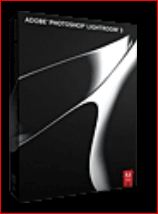
Version 3.0
Instead of a completely new review I'm just going to talk about the features new or greatly improved in Version 3.0. I think once you see what V3 can do you'll want to upgrade as soon as possible. Also, keep in mind that if you've recently
upgraded to an x64 Operating System such as Windows 7, that the x64 version of Lightroom 3 can use all your available RAM and all the cores and threads of your CPU which will make dramatic improvements in speed.
Version 3 is available from Adobe on a 30 day trial, or you can buy it for USD $299 or upgrade from a previous version for USD $99. You can choose here.
2010 RAW Processing Engine
The most important improvement to Version 3 is the inclusion of the new 2010 RAW engine. Previous versions used the 2003 version. 2010 is a dramatic improvement and even worth going back over some of your more prized or difficult images and starting from
scratch to get the benefits of this new raw processing engine.
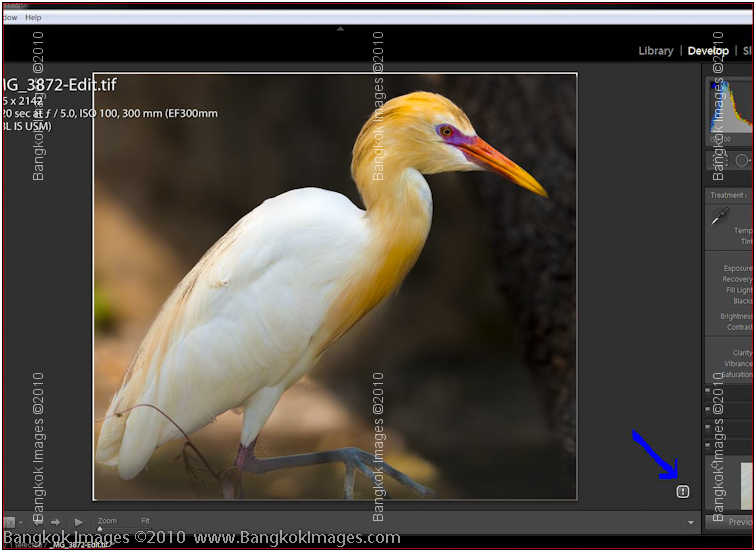
As you navigate to an older image previously processed with version 2003 you'll notice a small 'i' in the lower right corner. Click on it and you'll get the following dialog box.
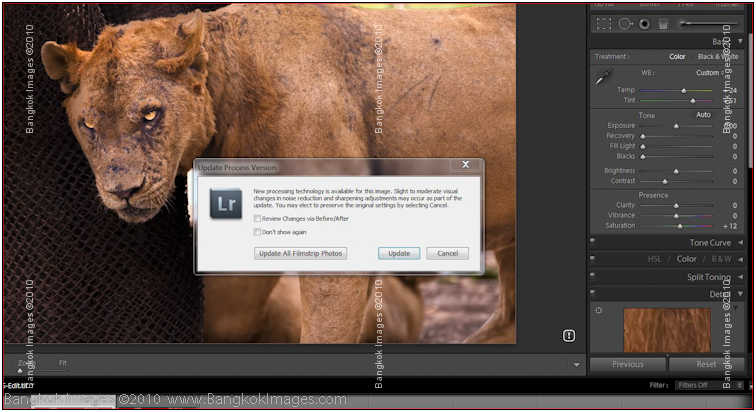
Now you'll get a dialog box informing you the image was processed with a earlier technology raw converter and that a new technology raw converter is available. You're given the choice of applying this choice to all images in the current folder.

You can also select to review a before and after difference using both technologies. I did this the first few times around and was delighted with the improvements. After I saw a few of them I set my entire catalog to use the new 2010 RAW engine.
Watermark Generator

As you can see there is now a dedicated watermark generator that allows you to create custom watermark profiles. This is especially useful and will allow you to possibly eliminate any utility watermark plug-ins you've been using previously. Once
you create these watermark profiles you can select them as desired from the export dialog box to apply as desired.
Import Module

This is big. The last import module left a lot to be desired and now we have all we desired. At the left of the module you can select where the images will be imported from, previous catalogs, different hard disks, thumb drives, card readers, its all
available.
Once you select your source then along the top middle you've given a choice of MOVING from the present location into the Lightroom catalog, COPYING from the current location into the Lightroom catalog as a location of your
choice, and ADDING the images to the Lightroom catalog from their current location.
Along the bottom you'll see two boxes labeled "Check All" and "Unselect All." The default is Check All, so if you only want to import select images from the source be sure to unselect the images you don't
wish to import.
Along the right side is where you choose where to import the images to. This pane is very much like the source pane on the left, but adds the ability to copy the images to two locations for backup purposes, add keywords which I highly recommend, or apply
presets such as black and white toning which I never use. By adding keywords at this point you'll save yourself much time as your image collection grows. Simple words to help identify your images such as Thailand, Bangkok, zoo, Daeng, lunch, tiger, temple, etc,
will help you find what you're looking for with ease years later when you've already forgotten what you've captured.
The import module is both fast and well organized and a joy to use. A great upgrade.
Noise Reduction
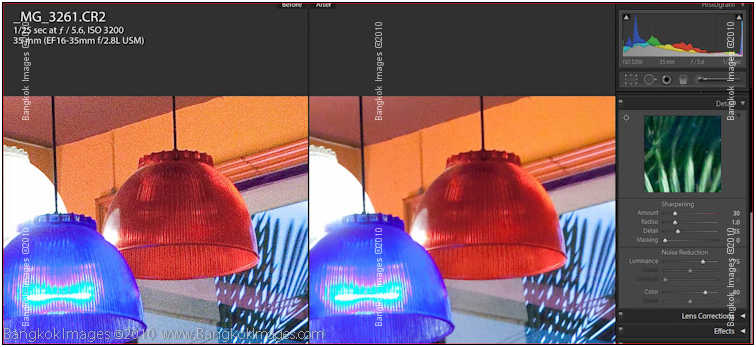
Noise reduction previously was something we needed to do in a stand alone noise reduction program such as Neat Image, Noise Ninja, Topaz DeNoise, or using a noise reduction plug-in in Photoshop. In any case we needed to export a TIFF or JPEG file and
remove noise as a separate and very time consuming function. Now we can do it from inside Lightroom on the RAW image which is technically a much better way of applying noise reduction and of course it will save you loads of time.
Tethered Shooting
Shooting tethered is a popular if not mandatory capability for studio shooters. By tethering your DSLR to the computer via a FW or USB cable you can see the images you just captured in real time. I used to feed these image in my studio to a large monitor
to provide instant feedback for the model. They loved it. This feedback allowed families sitting for portraits to adjust their pose or approve a specific setting. Working models loved it because it allowed them to see in real time their expressions,
errors, or any tiny adjustment needed. Shooting tethered also allows the photographer to adjust camera or lighting settings and to actually soft proof images during the actual shoot. This can save loads of time not to mention a possible re-shoot.
I've long wanted to incorporate tethered shooting in the field for advanced time lapse, focus bracketing, and exposure bracketing purposes. I've recentlyreviewed a new small field capable laptop I plan on using for this purpose and I hope to incorporate these techniques into advanced workshops very soon. Perhaps by the end of this month.
Lightroom now supports easy and simple tethering for most newer Nikon and Canon DSLRs. This is a very welcome feature and it works very well.
DSLR Video Files
With virtually every new DSLR hitting the market with advanced HD video capabilities it's about time a major imaging program supported these video files. Adobe Photoshop Lightroom 3 now includes support for video files. You can now store, file, organize
and easily manage your video files right alongside your still images. Editing capabilities are still limited, but just being able to see and view these files from within Lightroom is very welcome. I hope to thoroughly test this feature in the
future while test driving Sony's new NEX-5 system camera.
Flickr
Flickr and other photo social networking sites are becoming quite popular. Version 3 allows direct uploading to Flickr including movies made from slide shows. You can also find plug-ins for Lightroom to support other sites such as Smugmug. The best place
to look for these plug-in's is on the site itself. Lightroom is very popular and often the site will provide the plug-in at no charge to facilitate you uploads.
Film Grain Effects
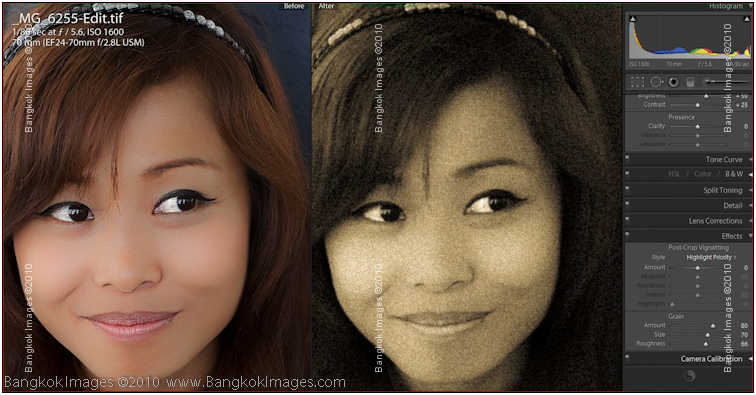
We spent the last decade improving cameras and software to get rid of "noise" which looks a lot like the film grain from older film images, and once we get nice clean images even at unheard of
ISO's, now we want to add back the film grain. Shoot me now.. 🙂
Actually, the problem with "noise" is that while it resembled film grain the character of the grain was quite different and not nearly as attractive. Many who shot film years ago fondly remember the look of film grain and have
long wished for a method to add this effect to their digital images. Lightroom 3 now provides that capability!
Lens Correction
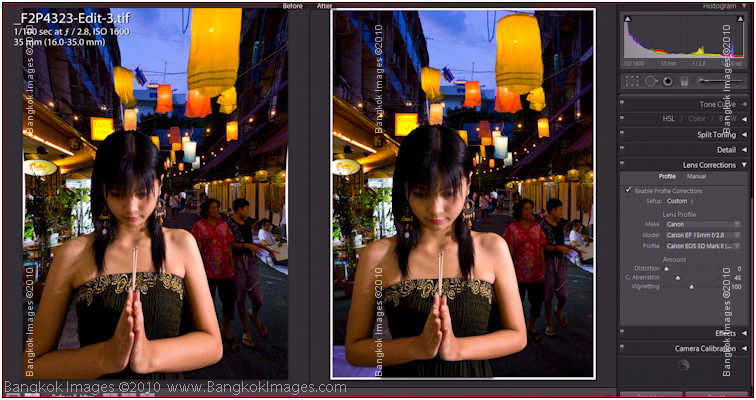
This is an extremely useful feature, especially if you shoot a lot of wide angle shots, and especially of buildings and interiors with many straight lines. Lens correction takes into account a specific lenses defects such as geometric distortion, vignetting,
and purple fringing (chromatic aberrations). It does this by access custom lens profiles that other uses have created for specific lenses and share on Adobe's site. You can also create your own. I find the standard profiles
Adobe provides work very well. Now, every image I import into Lightroom is corrected for the defects of the lens (most lenses have one to several imperfections that we've just learned to ignore) used without any intervention of effort
on my part. Mind you, we're talking lens distortion and not perspective distortion. Perspective distortion is still a hand task in Adobe's Photoshop. Still, being able to correct for the lens while still in RAW format is very useful
and will help improve the overall look of your images.
Print Module
This was a simple but very nice upgrade that allows you access more print packages for output printing.
Performance Tips
It's no secret that managing a great deal of photographs requires a great deal of processing power. Those of you with laptops might want to pass over this section because there's not much you can do to improve laptop performance other than buying
a powerful laptop and upgrading it with expensive SSD or Hybrid system and storage drives.
When building a workstation for processing images there are several rules to follow for best performance:
1. Select the fastest i7 processer you can afford. Please refer to my system build article here.
2. Add as much memory as you can afford, a minimum of 4g's and up to 12g's will show marked improvement in LR and other imaging programs.
3. Use fast hard drives and separate your system files and programs from your data via separate drives. Please read my review of SSD's here.
4. A nice graphic card will boost performance to a point. There is also a very real point of marginal returns concerning graphics cards. Please refer to my article on graphics cards here.
Even with all this computer power I noticed 'image to image' rendering on the screen took a half second or so. A half second adds up when you spend a lot of time on your workstation processing images. You want to get as much
work done in as little time as possible. So I set out to improve the image to image rendering.
First, I deleted all my previous indexes and preview images. I manage over 164,000 images in my current archive. My indexes and previews occupy about 1 terabyte of storage space. Today a 1tb drive is under $50 USD's. I had converted my version one
indexes and previews into Version 2, and then into Version 3, and while they were working I thought it would be best to rebuilt from scratch in Version 3 for the best (fastest) results.
Second, I added a fast storage 1tb storage drive to my workstation totally dedicated to the indexes and preview images. A clean format later I started the four day process of rebuilding my indexes and 1:1 preview images. 1:1 preview images means full size preview images.
Once finished I now had near instant movement from image to image. I say "near instant" because there is still a flicker of hesitation between each. As I zoom in on each image there is also a flicker of hesitation I estimate
to be less than 1/10th of a second. This means I can now move through over 164,000 images as fast as I want and never experience any waiting time or serious hesitation. This is really great. However I dream of faster..
So I moved my indexes and preview images for 10,000 images to a very fast SSD and the hesitation totally disappeared. Of course I'm not going to foot the bill to buy a 1tb SSD (about $3000 USD's) just to use for indexes and
previews but this gave me an idea. Seagate, at the end of this month, will be releasing its Momentus Hybrid Laptop drives. In testing these drives out performed ALL 3.5 inch SATA II mechanical hard drives including Western Digital's just
released 600gb Raptor. This is incredible performance! These are hybrid mechanical and SSD drives 500gb in capacity, 2.5 inch (laptop size), and run $139 USD's on Amazon.com which I think is a bargain. I ordered several to use as
index and preview drives and a few more to upgrade the few laptops I have remaining which already haven't been upgraded with a SSD. I'll do a full review on these hybrid drives when they arrive.
Summary

I'm very pleased with Adobe Photoshop Lightroom Version 3. The features it adds are very well implemented and the performance upgrades with the RAW engines monumental. More performance, better image quality, and more time saving features at the RAW
level. So far this is a winning combination.
Adobe allowed licensed users of previous versions to upgrade to the latest version for a very reasonable $99.
Is Lightroom perfect? No. Not by a long shot. There is still much room for improvement and the addition of new features and even better performance. Adobe of course will answer this call with further improvements in its incremental upgrades with the more
significant improvements coming in Version 4. And I'm sure there will be a Version 5 and 6 and more. This is the nature of imaging software.
This is the main piece of imaging software I not only recommend, but the one I use personally and the one I teach. I recommend this with no reservations knowing it's the most complete serious imaging program available.
Photography News of Interest *menu
It is no secret the Sony NEX-3 and NEX-5 camera has caught my attention. Smaller than the smallest Micro-4/3's camera but with a much bigger 4/3's sensor. I currently have one
of the first 100 NEX-5's on the market and am giving it a thorough testing. Now I see RayQual is introducing a lens adapter that will enable me
to use either my Canon or Nikon DSLR lenses with my new NEX-5! The entire purpose of this type of camera is to benefit from a small size, so I really don't think hanging one of my big F2.8 zooms on it is necessarily a good idea. But what
about something like the excellent Nikon 45mm P series manual focus pancake lens? I'm intrigued.

Glowing Photography? S. Korean photographer Bo Bae Kim makes some unique captures of unique moments that you've just got to see to understand. Check our this article for more.

Underwater paint photography.. a strange idea but some really awesome images! This extremely creative series called "Aqueous" was created by photographing paint dropped in water. Obviously this is time sensitive work. Check out Mark Mawson's stunningly beautiful work here..

Are you in the market for an incredibly reliable underwater camera housing for your Nikon Coolpix L18? A Nikon Coolpix L18 encased inan Ikelight underwater housing was lost of the coast of Aruba and washed ashore six months later off of Key West Florida! It was covered with a thick layer of marine growth and probably didn't smell that great, but the camera and flash memory inside were fine. Do you think the
battery still had a charge?

Do you want your Panasonic GH1 to have the capability to record 1080p video like the Canon 5d Mark II? Are you willing to install hacked firmware and risk 'bricking' your camera?
If you're not willing to wait for Panasonic to bring you this feature and are willing to assume the risks, this article is what you've been waiting
for.

Phase One releases Capture One Pro 4 version 5.1.2 supporting a few new digital camera models. You can download your upgrade here. Phase One is also running a special where if you already own a copy of Expressions 2 software, and a copy of Capture One Pro, then you qualify for a free upgrade to the soon to be released Capture One Pro 5.

Has the camera replaced the car as the ultimate male status symbol? This article from Ask Men seems to think so. Vintage cars are built like vintage cameras? A no-nonsense point and shoot is the same as an economy car? Cameras impart power? Endless upgrade options? And of course status. This writer may have a point. Check out this fun
article and weigh in with your opinion.

Readers Submissions *menu
Hi
Here a few samples from day two Singapore.
Note the different backgrounds again.
All significant landmarks.
Bart








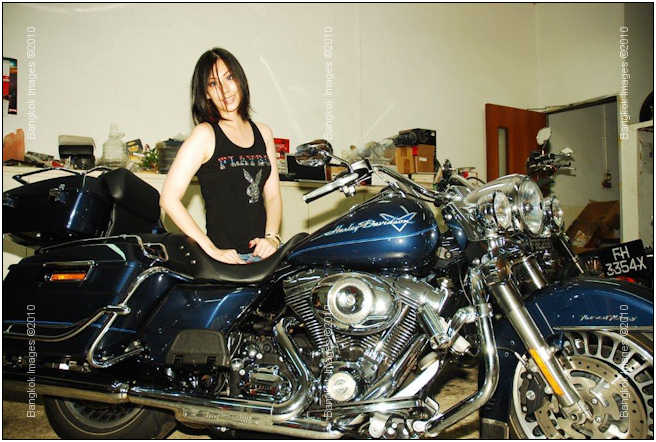
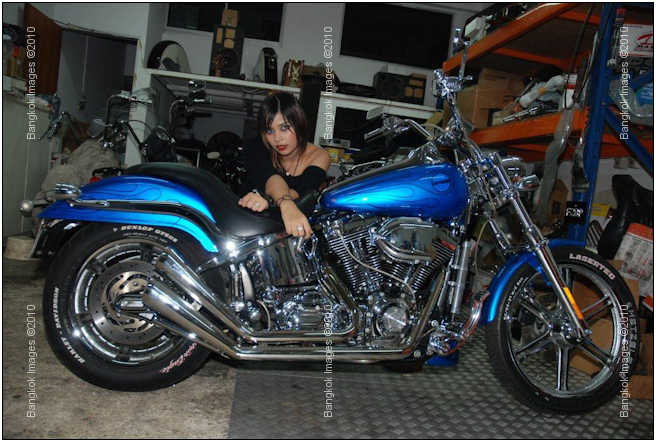
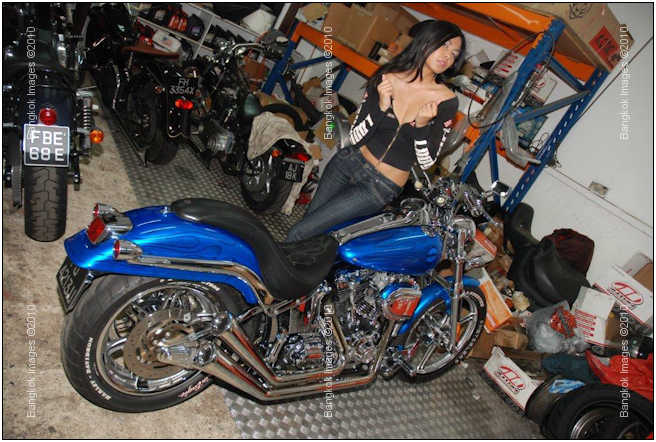
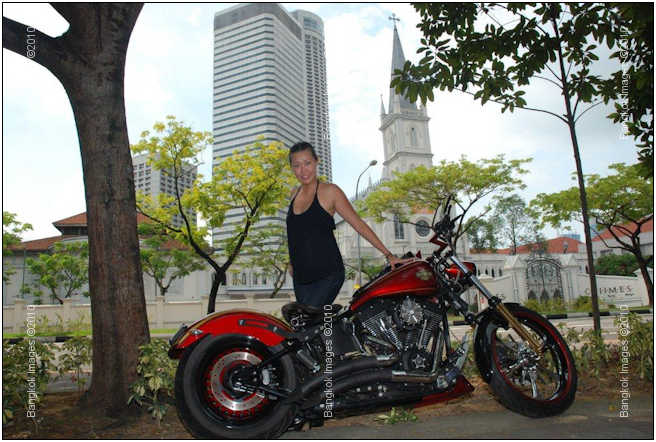
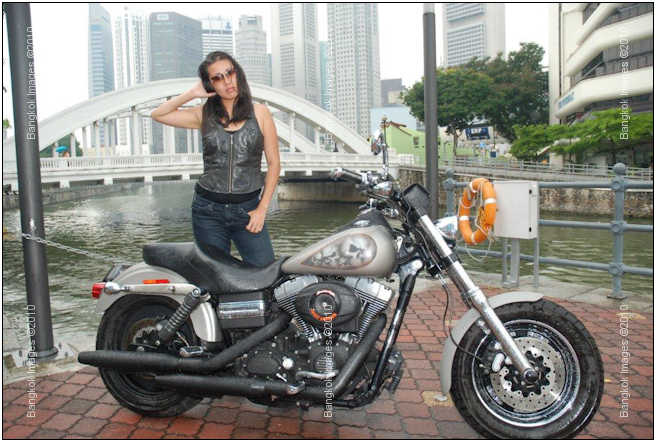
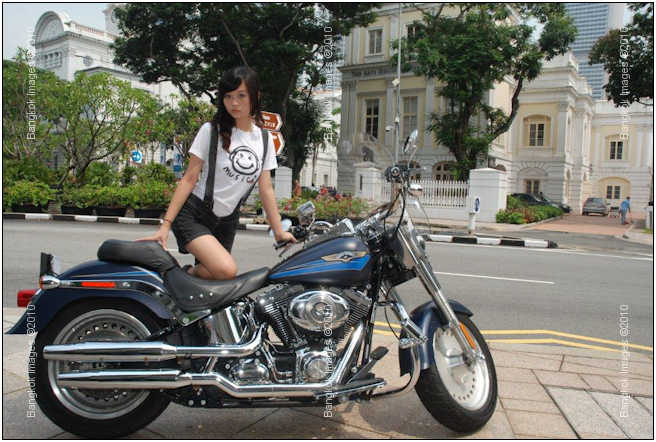

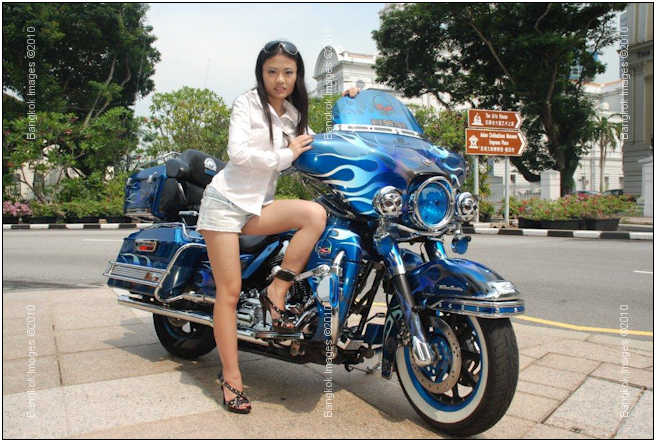

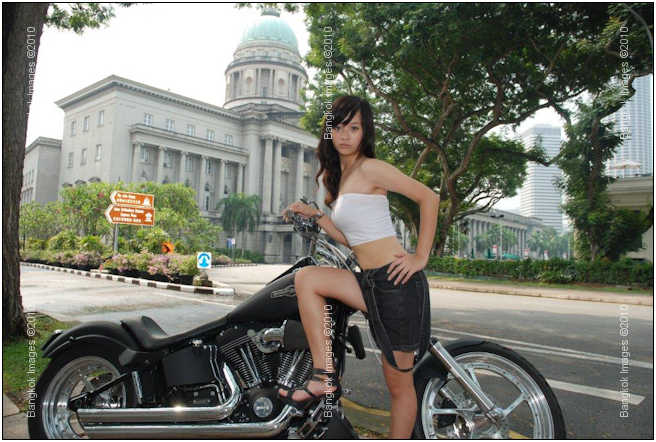

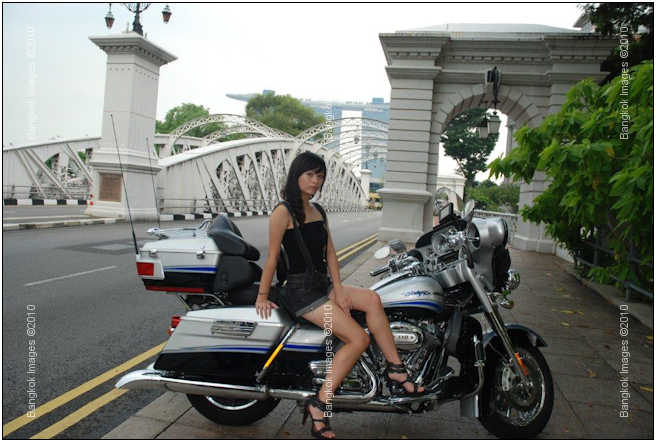
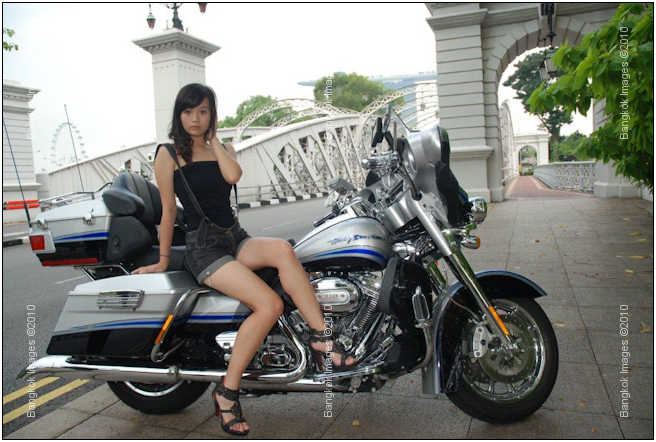
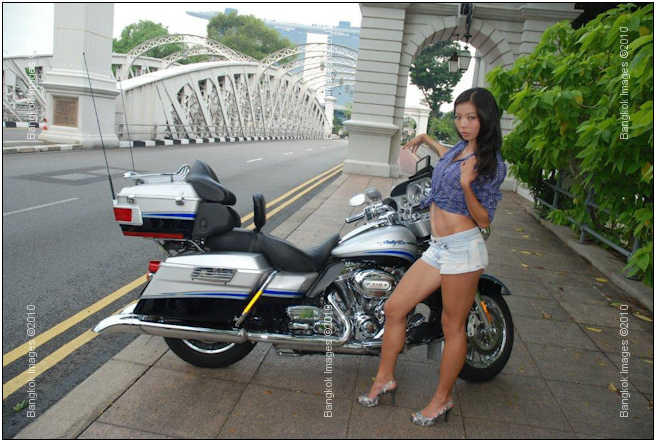
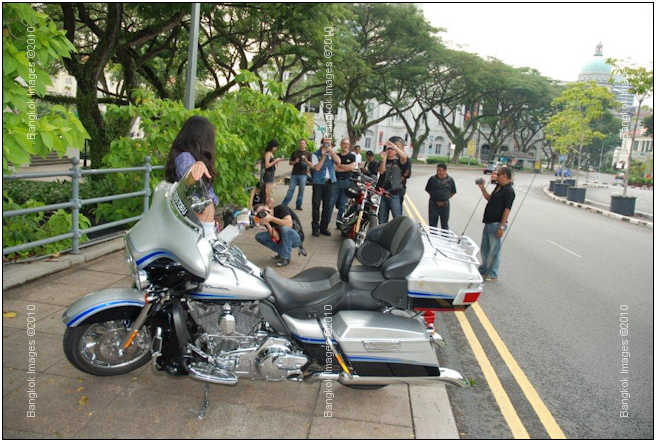
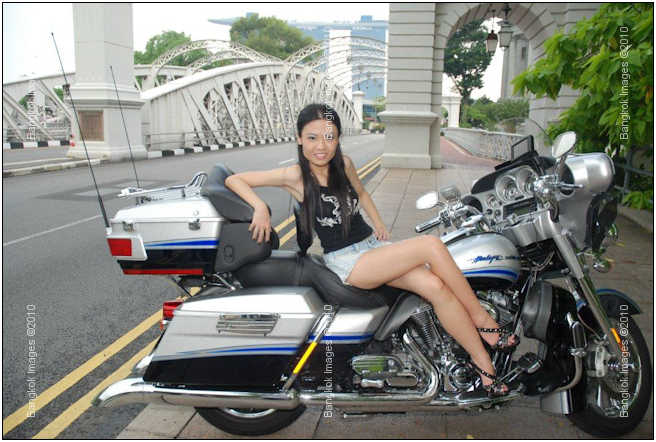
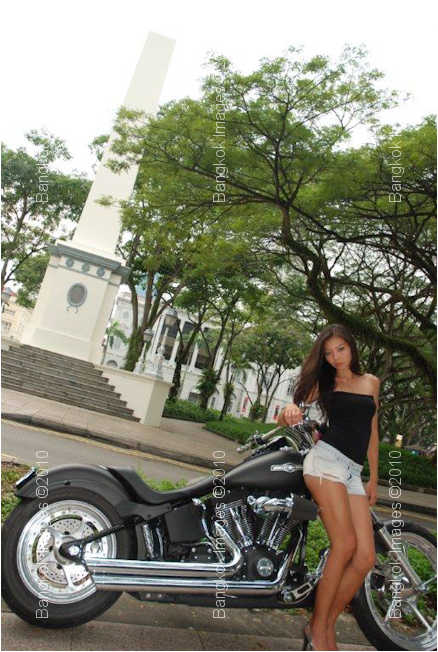

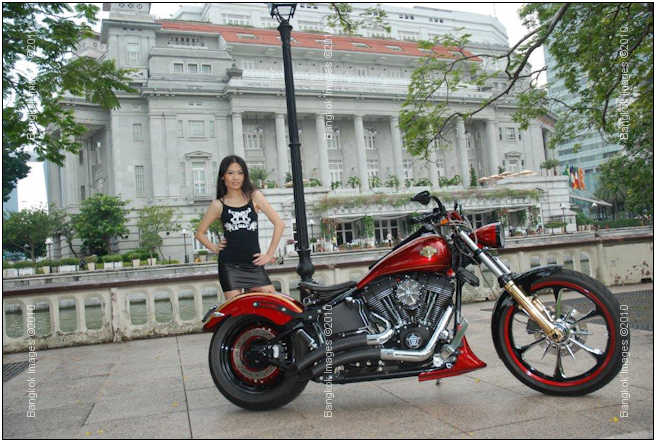



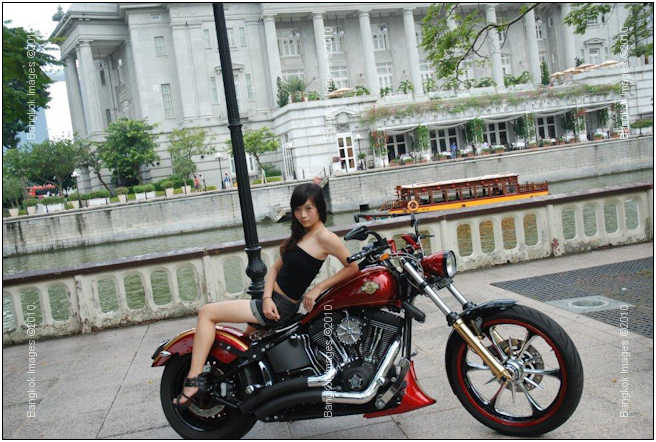


Bart – These are some really fun shots!
I suspect the readers submissions will be a highly anticipated section of this column and I encourage anyone with photographs and travel accounts they'd like to share to please send them to me at: info@BangkokImages.com
Readers Questions *menu
This week I ask a question from The Professor in the forums of Bangkok Images and receive back an interesting reply. Follow along:
Dear Professor;
Recently I had our company logo printed on magnetic signs for our company vehicle. Personally I think the orange colors on black and the gold from the reclining Buddha look pretty good..
However, driving around Bangkok these last few days I've been getting a lot of STARES from Thai people.. who coincidently appear to make up the majority of drivers on the road.. I was a bit worried about this, it's not like I have the big Mo on my rear doors.. but how do Buddhist feel about displaying the Buddha image in this manner?
Today going into a US Embassy compound the Thai security guards made a big deal over the signs, showed their friends, smiled, and then gave me a huge thumbs up! It makes me feel better.. but is this just their opinion and am I likely to encounter different reactions as I travel throughout Thailand?
I can't think of any other image that represents Thailand as much as the Reclining Buddha except perhaps the Emerald Buddha which is held in higher reverence. A floating market scene or a insect frying street vendor just wouldn't have the same impact.
It's not like I had all the Southpark Religious Personality cartoons made into a sign.. and I want to be respectful.. but cutting edge.. edgy..
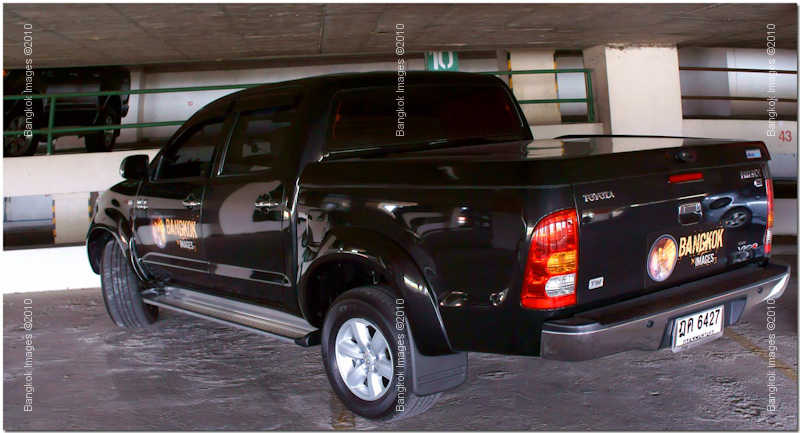
Sony NEX-5 @F5.6 A mode 24mm ISO 1600
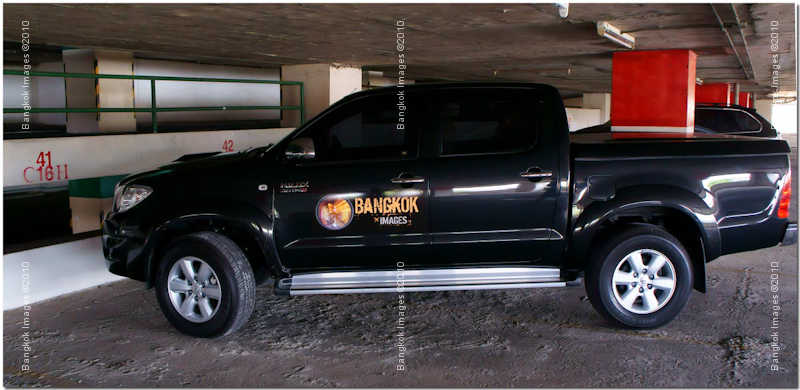
Sony NEX-5 @F5.6 A mode 24mm ISO 1600
BKKSteve –
Are you sure other drivers weren't staring at you because of your driving style of Somchai taxi driver incarnated.. ?
On a serious note though, we all know that in Thai culture head is considered a 'high' thing and needs to be put higher than other things, and there are 'low' things that should stay lower than all other things.
When you walk pass someone older than you, you will not walk tall, but will have to bend your back, or even walk on your knees, so that the level of your head is lower than the older person's. And you will keep your lowly feet away from
other people and never point them in other people's direction.
Buddha images, pictures of the Royal family, Thai flag, books, head and stuff you use on your head, etc, are things you don't lay around on the floor.
Your logo looks great and I like it.. and I don't see anything wrong with the Buddha image on the logo. The guard at the US Embassy must have thought the same.. But for some Thai people they might not like the idea of the Buddha image
being hauled around.. and the level of the Buddha image close to your buttock.. or your feet on the other side of the door..
I remember when I was going to school in Los Angeles.. we were at the church on campus learning how to play handbells. I set a huge and heavy case of handbells on communion table. My professor screamed like a little girl. I thought.. why
the scream? It's just a table..
Another example.. at the Sanctuary of Truth.. they gave us a sticker to put on our shirts as a ticket after we pay the entrance fee. I put the sticker on my ankle just because I didn't want to put it where everyone else did.. Then someone
walked up to me and asked me to move the sticker to my collar. The reason was there was picture of the Sanctuary on the sticker and should not be put on lower parts of anyone's body.
This is all subjective..
JTG
Please submit your questions to info@BangkokImages.com All questions will be answered and most will show up in the weekly column.
A Snapshot of Bangkok Images Week in Review *menu

These last few weeks have been very busy for me personally and for Bangkok Images. Last week we didn't have a column because a defective brand new computer add-in card shorted out my motherboard and the installation of a new motherboard required
all sorts of updates and changes to the system in general. I'm pleased to say we're now up and operating better than ever.
We've also made the transition to Lightroom 3.0 complete. We've built new indexes and previews which was a several day project because our archives are huge.
Meanwhile we received our second imaging monitor from NEC and we have it installed and profiled so the pair is now online. I intended to write a review about the monitors and my experience obtaining them in the Kingdom, sometime in July I'd guess.
They delivered the second hood system a week later and the hoods are now attached.
Several new pieces of hardware including the brand new Sony NEX-5 pocket camera with a DSLR sized APC-S sensor, a new 40g Intel SSD to compliment one of our laptops that holds two HDD's, a new Android 2.1 HTC Desire smart phone to better keep in
touch with our clientele while on the road, and a few things I'll mention next week once they're unwrapped and I decide if they're worth reviewing or not.
Do you have a new camera or lens and would like to see it reviewed here? If you live locally and don't mind loaning it to me for a few days I'd love to test your gear and give my opinion/impression in the form of a thoughtful and hopefully useful
review to share with all. Shoot me an email at info@BangkokImages.com if you do.
The website is up on it's new server and performance gains are huge. If the site initially turned you off due to poor performance please give it another try. I think you'll be pleased.
Dana has submitted his 3rd Thailand Photo Story andyou can see it here. These are short, fun, and often hilarious stories with a
photography slant. Check them out!
I'm going to start listing a "Gallery of the Week" to help showcase Bangkok Images members who post galleries on the site. Many of these galleries hold interesting images and are certainly worth a look. This weekcheck out Sunny Valentine's galleries on Bangkok Images!
My son arrived for the summer and this is the best time of my year.
Infocus Blog, Yanhee General Hospital *menu
Today my son and I had an interesting experience. He has a small mole he wanted removed so on a friends advice we visited a plastic surgeon at Yahoo General Hospital. This is an older public hospital on the other side of the river and compared to Bumrungrad
and BNH is extremely crowded and not nearly as well kept.
Despite it's age and obvious disparity in operating budgets the staff were very friendly and everyone we needed to speak with understood and spoke very decent English. They were both professional and efficient and we never had to wait more than a
few minutes.

Sony NEX-5 @F8 A mode 72mm ISO 3200
The real fun started in their very busy and crowded plastic surgery department. Cute girls on roller blades delivering files, and nurses who had obviously benefitted from their departments specialty. Everyone seemed intent on looking as perfect as possible!
Noses, cheeks, butts, boobs, and eyes.. every part of the human body is open for improvement at Yanhee General Hospital.

Sony NEX-5 @F8 A mode 65mm ISO 3200
An interesting phenomenon in the waiting area was everyone trying their best to check everyone else out without being noticed. It seemed common for both males and females alike to check out each others new body parts.
Noses from all over the world attached to Thai faces, eyes of all shapes, and lips of the stars. Nothing was missing. In a way it was like the game Mr. Potato Head. Remember Mr. Potato Head as a child? You asked your mom for an unused potato from the
kitchen and then stuck on a hat, eyes, a nose and maybe a mustache.. you built your Mr. Potato Head in your own image or someone else's. There were lots and lots of Mr. Potato Head gamers at Yanhee!
Yanhee General Hospital also earns this years top award for the tightest possible female uniforms. I'd swear some were painted on with a spray gun!

Sony NEX-5 @F8 A mode 78mm ISO 3200
Our office visit with the doctor was the most impressive. It has been my experience that if a Thai doctor can get you to pay for a test or procedure then they'll gently if not forcefully push you in that direction whether its needed or in your best
interest or not. After all, it's money in their pockets. This doctor advised us to wait and return in a month to see if the mole removal would be better accomplished then. And he didn't charge a single baht for the visit! Total cost
for today's visit to Yanhee hospital was baht 100, an admin fee. Overall, despite the enthusiasm for plastic surgery, this hospital seemed well ran, the staff more than helpful, and it gave the impression of being the virtual beehive of activity.

Sony NEX-5 @F8 A mode 24mm ISO 3200
Until next time..



